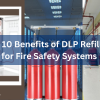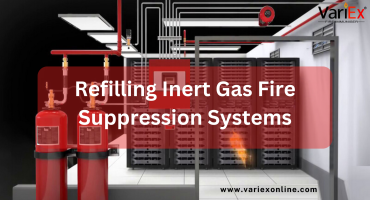![]()
Fire Immuniser
+91-7829629111
Email: info@variex.in
Varistor Technologies Pvt. Ltd.
Block-1, First Floor, Ardente Office One, Hoodi Circle, ITPL Main Road, Bengaluru, Karnataka 560048, IN
Automatic Fire Suppression System For Electrical Panels
Automatic fire suppression systems for electrical panels are vital components of fire safety infrastructure in various industries and facilities. These systems are designed to detect and suppress fires quickly, minimizing damage to critical electrical equipment and reducing the risk of injuries or fatalities. In this informational content, we'll explore the features, benefits, installation considerations, and operational aspects of automatic fire suppression systems tailored for electrical panels.
Features of Automatic Fire Suppression Systems:
- Detection Mechanisms: Automatic fire suppression systems incorporate advanced detection mechanisms, such as heat sensors, smoke detectors, or flame detectors, to swiftly identify fire incidents within electrical panels.
- Suppression Agents: These systems utilize suppression agents, including clean agents like FM-200 or CO2, or dry chemical agents, to extinguish fires effectively without causing harm to sensitive electronic equipment.
- Activation Mechanism: Upon detecting a fire, the system automatically activates the suppression agent release mechanism, ensuring rapid response and containment of the fire.
- Control Panel Integration: Automatic fire suppression systems are integrated with control panels, allowing for centralized monitoring, diagnostics, and remote activation of the suppression system.
Benefits of Automatic Fire Suppression Systems:
- Rapid Response: Automatic detection and suppression capabilities enable these systems to respond swiftly to fire incidents, reducing the likelihood of fire escalation and minimizing damage.
- 24/7 Protection: Automatic fire suppression systems operate autonomously, providing round-the-clock protection for electrical panels even when personnel are not present.
- Minimized Downtime: By extinguishing fires promptly, these systems help minimize equipment damage and downtime, ensuring uninterrupted operations and productivity.
- Safety Assurance: Automatic fire suppression systems enhance occupant safety by containing fires at their source and preventing their spread to other areas of the facility.
Installation Considerations:
- Proper Placement: Suppression agents and detection devices should be strategically positioned to ensure comprehensive coverage of the electrical panels and surrounding areas.
- Compatibility: The selection of suppression agents and system components should consider the compatibility with electrical equipment and environmental factors to avoid damage or adverse effects.
- Regulatory Compliance: Installation of automatic fire suppression systems should adhere to relevant industry standards and regulations, such as NFPA 12, to ensure legal compliance and operational effectiveness.
Operational Aspects:
- Regular Maintenance: Routine inspections, functional tests, and maintenance activities are essential to verify the integrity and performance of automatic fire suppression systems and ensure readiness for emergencies.
- Training: Personnel should receive proper training on the operation, maintenance, and emergency procedures associated with automatic fire suppression systems to facilitate effective response and coordination during fire incidents.
- Documentation: Comprehensive records of installation, maintenance, testing, and training activities should be maintained for regulatory compliance, accountability, and audit purposes.
Understanding Automatic Fire Suppression Systems:
- Detection Mechanisms: Automatic fire suppression systems employ various detection technologies, including heat sensors, smoke detectors, and flame detectors, to identify fire incidents within electrical panels accurately.
- Suppression Agents: These systems utilize different suppression agents, such as clean agents like FM-200, CO2, or inert gases, or dry chemical agents like ABC powder, to extinguish fires swiftly and effectively.
- Activation Mechanism: Upon detecting a fire, automatic suppression systems trigger the release of the suppression agent through a network of piping and nozzles, ensuring rapid response and containment of the fire.
- Control Panel Integration: Automatic fire suppression systems are integrated with control panels, enabling centralized monitoring, diagnostics, and automatic activation of the suppression system upon detection of a fire event.
Benefits of Automatic Fire Suppression Systems:
- Rapid Response: Automatic detection and suppression capabilities enable these systems to respond within seconds of detecting a fire, minimizing damage and reducing the risk of fire escalation.
- 24/7 Protection: Automatic fire suppression systems operate autonomously, providing continuous protection for electrical panels, even in unoccupied areas or during off-hours.
- Equipment Preservation: By extinguishing fires swiftly and without causing additional damage, these systems help preserve critical electrical equipment, minimizing downtime and replacement costs.
- Occupant Safety: Automatic fire suppression systems enhance occupant safety by containing fires at their source and preventing their spread to other areas of the facility, allowing for safe evacuation.
Installation Considerations:
- System Design: Proper system design is essential to ensure comprehensive coverage of electrical panels and surrounding areas, taking into account factors such as room layout, equipment placement, and fire hazards.
- Component Compatibility: Suppression agents and system components must be compatible with the specific requirements of electrical equipment and environmental conditions to ensure effective and safe operation.
- Regulatory Compliance: Installation of automatic fire suppression systems must comply with relevant industry standards and regulations, such as NFPA 12, ensuring legal compliance and operational effectiveness.
Maintenance Requirements:
- Regular Inspections: Routine inspections, functional tests, and maintenance activities are crucial to verify the integrity and performance of automatic fire suppression systems, ensuring readiness for emergencies.
- Scheduled Maintenance: Maintenance tasks, such as cylinder pressure checks, nozzle cleaning, and control panel testing, should be performed according to manufacturer recommendations and regulatory requirements.
- Documentation: Comprehensive records of installation, maintenance, testing, and training activities should be maintained for regulatory compliance, accountability, and audit purposes.
Regulatory Considerations:
- NFPA Standards: Compliance with National Fire Protection Association (NFPA) standards, such as NFPA 12 for carbon dioxide fire suppression systems, is essential to ensure the effectiveness and safety of automatic fire suppression systems.
- Local Regulations: Installation, operation, and maintenance of automatic fire suppression systems may be subject to local fire codes and regulations, which vary depending on jurisdiction. It is imperative to adhere to these regulations to ensure legal compliance and operational safety.
Conclusion
Automatic fire suppression systems are indispensable assets in protecting electrical panels and ensuring the safety and continuity of operations in various industries and facilities. With their advanced detection and suppression capabilities, these systems offer rapid response to fire incidents, minimizing damage and downtime while enhancing occupant safety. Proper installation, maintenance, and regulatory compliance are essential for maximizing the effectiveness and reliability of automatic fire suppression systems for electrical panels.
Frequently Asked Questions
An automatic fire suppression system for electrical panels is a specialized system designed to detect and suppress fires automatically within electrical enclosures using various detection mechanisms and suppression agents.
Automatic fire suppression systems utilize advanced detection technologies to identify fire incidents within electrical panels. Upon detection, the system triggers the release of a suppression agent, such as CO2 or clean agents, to extinguish the fire swiftly and prevent its spread.
Automatic fire suppression systems offer rapid response times, 24/7 protection, equipment preservation, and enhanced occupant safety. These systems minimize damage, reduce downtime, and ensure continuity of operations in various industrial and commercial settings.
Automatic fire suppression systems should undergo regular inspections, functional tests, and maintenance activities according to manufacturer recommendations and regulatory requirements. This typically involves scheduled inspections, pressure testing of cylinders, and documentation of maintenance activities.
Yes, safety is paramount when using automatic fire suppression systems. Proper ventilation, clear evacuation procedures, warning signage, and personnel training are essential to ensure occupant safety during system activation and maintenance.
Final Say
We at VariEx.in or Variexonline.com have mastered the art of designing, installing, inspecting, and fixing automatic sprinkler systems with the help of our in-house team, which is capable of delivering the fire sprinkler services you need, whether large or small and at affordable cost.
To schedule a fire sprinkler installation, or you think our services could benefit your commercial property, contact us online or give us a call at, 7829629111









